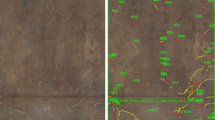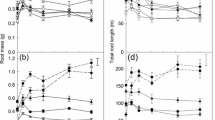Abstract
The root morphology of ten temperate pasture species (four annual grasses, four perennial grasses and two annual dicots) was compared and their responses to P and N deficiency were characterised. Root morphologies differed markedly; some species had relatively fine and extensive root systems (Vulpia spp., Holcus lanatus L. and Lolium rigidum Gaudin), whilst others had relatively thick and small root systems (Trifolium subterraneum L. and Phalaris aquatica L.). Most species increased the proportion of dry matter allocated to the root system at low P and N, compared with that at optimal nutrient supply. Most species also decreased root diameter and increased specific root length in response to P deficiency. Only some of the species responded to N deficiency in this way. Root morphology was important for the acquisition of P, a nutrient for which supply to the plant depends on root exploration of soil and on diffusion to the root surface. Species with fine, extensive root systems had low external P requirements for maximum growth and those with thick, small root systems generally had high external P requirements. These intrinsic root characteristics were more important determinants of P requirement than changes in root morphology in response to P deficiency. Species with different N requirements could not be distinguished clearly by their root morphological attributes or their response to N deficiency, presumably because mass flow is relatively more important for N supply to roots in soil.
Similar content being viewed by others
References
Arsenault J L, Pouleur S, Messier C and Guay R (1995). WinRHIZ O, a root-measuring system with a unique overlap correction method. Hort. Sci. 30: 906
Baan Hofman T and Ennic G C (1980). Investigation into plant characters affecting the competitive ability of perennial ryegrass (Lolium perenne L.). Neth. J. Agr. Sci. 30: 97–109
Baan Hofman T and Ennic G C (1982). The effect of root mass of perennial ryegrass (Lolium perenne L.) on the competitive ability with respect to couch grass (Elytrigia repens (L.) Desv.). Neth. J. Agr. Sci. 30: 275–283
Barber S A and Silberbush M (1984). Plant root morphology and nutrient uptake. In: Kral, D M (eds) Roots, Nutrient and Water Influx and Plant Growth: Proceedings of a Symposium, pp 65–87. American Society of Agronomy, Madison
Barrett D J and Gifford R M (1999). Increased C-gain by an endemic Australian pasture grass at elevated atmospheric CO2 concentration when supplied with non-labile inorganic phosphorus. Aust. J. Plant Physiol. 26: 443–451
Bolan N S, Robson A D and Barrow N J (1987). Effects of phosphorus application and mycorrhizal inoculation on root characteristics of subterranean clover and ryegrass in relation to phosphorus uptake. Plant Soil 104: 294–298
Boot R G A (1989). The significance of size and morphology of root systems for nutrient acquisition and competition. In: Lambers, H, Cambridge, M L, Konings, H and Pons, T L (eds) Causes and Consequences of Variation in Growth Rate and Productivity of Higher Plants, pp 299–311. SPB Academic Publishers, The Hague
Boot G A and Mensink M (1990). Size and morphology of root systems of perennial grasses from contrasting habitats as affected by nitrogen supply. Plant Soil 129: 291–299
Boot R G A and Mensink M (1991). The influence of nitrogen availability on growth parameters of fast- and slow-growing perennial grasses. In: Atkinson, D (eds) Plant Root Growth: An Ecological Perspective, pp 161–168. Blackwell Sci. Publications, Oxford
Bradshaw A D, Chadwick M J, Jowett D, Lodge R W and Snaydon R W (1960). Experimental investigations into the mineral nutrition of several grass species. III. Phosphate level. J. Ecol. 48: 631–637
Bradshaw A D, Chadwick M J, Jowett D and Snaydon R W (1964). Experimental investigations into the mineral nutrition of several grass species. IV. Nitrogen level. J. Ecol. 52: 665–676
Brouwer R (1983). Functional equilibrium? Sense or nonsense?. Neth. J. Agr. Sci. 31: 335–348
Burkitt L L, Moody P W, Gourley C J P and Hannah M C (2002). A simple phosphorus buffering index for Australian soils. Aust. J. Soil Res. 40: 497–513
Caldwell M M and Camp L B (1974). Below-ground productivity of two cool desert communities. Oecologia 17: 123–130
Caldwell M M, Manwaring J H and Jackson R B (1991a). Exploitation of phosphate from fertile soil microsites by three Great Basin perennials when in competition. Funct. Ecol. 5: 757–764
Caldwell M M, Manwaring J H and Durham S L (1991b). The microscale distribution of neighbouring plant roots in fertile soil microsites. Funct. Ecol. 5: 765–772
Chapin F S (1980). The mineral nutrition of wild plants. Annu. Rev. Ecol. Syst. 11: 233–260
Chapin F S, Bloom A J, Field C B and Waring R H (1987). Plant responses to multiple environmental factors. Bioscience 37: 49–57
Christie E K (1975). Physiological responses of semiarid grasses. II The pattern of root growth in relation to external phosphorus concentration. Aust. J. Agr. Res. 26: 437–446
Christie E K and Moorby J (1975). Physiological responses of semiarid grasses. I The influence of phosphorus supply on growth and phosphorus absorption. Aust. J. Agr. Res. 26: 423–436
Colwell J D (1963). The estimation of the phosphorus fertiliser requirements of wheat in southern New South Wales by soil analysis. Aust. J. Exp. Agr. 3: 190–198
Eddy D, Mallinson D, Rehwinkel R and Sharp S (1998). Grassland Flora. A Field Guide for the Southern Tablelands (NSW and ACT). Environment ACT, Canberra, 156
Eissenstat D M (1992). Costs and benefits of constructing roots of small diameter. J. Plant Nutr. 15: 763–782
Fan M, Zhu J, Richards C, Brown K M and Lynch J P (2003). Physiological roles for aerenchyma in phosphorus-stressed roots. Funct. Plant Biol. 30: 493–506
Fitter A H (1985). Functional significance of root morphology and root system architecture. In: Fitter, A H, Atkinson, D, Read, D J and Usher, M B (eds) Ecological Interactions in Soil: Plant, Microbes, and Animals, pp 87–106. Blackwell Sci. Publ, London
Fransen B and Blijjenberg J (1999). Root morphological and physiological plasticity of perennial grass species and the exploitation of spatial and temporal heterogeneous nutrient patches. Plant Soil 211: 179–189
Gahoonia T S, Care D and Nielsen N E (1997). Root hairs and phosphorus acquisition of wheat and barley cultivars. Plant Soil 191: 181–188
Gardner W K, Barber D A and Parbery D G (1983). The acquisition of phosphorus by Lupinus albus L. III. The probable mechanism by which phosphorus movement in the soil/root interface is enhanced. Plant Soil 70: 107–124
Gifford R M, Lutze J L and Barrett D J (1996). Global atmospheric change effects on terrestrial carbon sequestration: exploration with a global C- and N-cycle model (CQUESTN). Plant Soil 187: 369–387
Grime J P (1979). Plant Strategies and Vegetation Processes. Wiley, Chichester, 222
Hill J O, Simpson R J, Moore A D, Graham P and Chapman D F (2004). Impact of phosphorus application and sheep grazing on the botanical composition of sown pasture and naturalised, native grass pasture. Aust. J. Agr. Res. 55: 1213–1225
Hill J O, Simpson R J, Wood J T, Moore A D and Chapman D F (2005). The phosphorus and nitrogen requirements of temperate pasture species and their influence on grassland botanical composition. Aust. J. Agr. Res. 56: 1027–1039
Hodge A, Robinson D, Griffiths B S and Fitter A H (1999). Why plants bother: root proliferation results in increased nitrogen capture from an organic patch when two grasses compete. Plant Cell Environ. 22: 811–820
Hodge A, Stewart J, Robinson D, Griffiths B S and Fitter A H (1998). Root proliferation, soil fauna and plant nitrogen capture from nutrient-rich patches in soil. New Phytol. 139: 479–494
Isbell R F (1996). The Australian Soil Classification. CSIRO, Melbourne, 143
Lamp C A, Forbes S J and Cade J W (1990). Grasses of Temperate Australia. Inkata Press, Melbourne, 310
Lynch J P and Brown K M (2001). Topsoil foraging – an architectural adaptation of plants to low phosphorus availability. Plant Soil 237: 225–237
Moore R M (1970). Australian grasslands. In: Moore, R M (eds) Australian Grasslands, pp 87–100. Australian National University Press, Canberra
Nye P H (1973). The relation between the radius of a root and its nutrient absorbing power. J. Exp. Bot. 24: 783–786
Poorter H and Nagel O (2000). The role of biomass allocation in the growth response of plants to different levels of light, CO2, nutrients and water: a quantitative review. Aust. J. Plant Physiol. 27: 595–607
Powell C L (1974). Effect of P-fertiliser on root morphology and P uptake of Carex coriacea. Plant Soil 41: 661–667
Rayment G E and Higginson F R 1992 Australian laboratory handbook of soil and water chemical methods. Inkata Press, Melbourne 330 pp
Robinson D, Linehan D J and Gordon D C (1994). Capture of nitrate from soil by wheat in relation to root length, nitrogen inflow and availability. New Phytol. 128: 297–305
Robinson D and Rorison I H (1988). Plasticity in grass species in relation to nitrogen supply. Funct. Ecol. 2: 249–257
Rossiter R C (1964). The effect of phosphate supply on the growth and botanical composition of annual type pasture. Aust. J. Agr. Res. 15: 61–76
Ryser P and Lambers H (1995). Root and leaf attributes accounting for the performance of fast- and slow-growing grasses at different nutrient supply. Plant Soil 170: 251–265
Saunders W M H and Williams E G 1955 Observations on the determination of total organic phosphorus in soil. J. Soil Sci. 6, 254–267
Schippers P and Olff H (2000). Biomass partitioning, architecture and turnover of six herbaceous species from habitats with different nutrient supply. Plant Ecol. 149: 219–231
Shaver G R and Billings W D (1975). Root production and root turnover in a wet tundra ecosystem. Barrow, Alaska. Ecol. 56: 401–409
Smith F W and Loneragan J F (1997). Interpretation of plant analysis: Concepts and principles. In: Reuter, D J and Robinson, J B (eds) Plant Analysis. An Interpretation Manual, pp 1–33. CSIRO Publishing, Melbourne
Smith S E and Read D J (1997). Mycorrhizal Symbiosis. Academic Press, San Diego, 605
Tiver N S and Crocker R L (1951). The grasslands of south-east South Australia in relation to climate, soils and developmental history. J. Brit. Grassl. Soc. 6: 29–80
Author information
Authors and Affiliations
Corresponding author
Additional information
Section editor: H. Lambers
Rights and permissions
About this article
Cite this article
Hill, J.O., Simpson, R.J., Moore, A.D. et al. Morphology and response of roots of pasture species to phosphorus and nitrogen nutrition. Plant Soil 286, 7–19 (2006). https://doi.org/10.1007/s11104-006-0014-3
Received:
Accepted:
Published:
Issue Date:
DOI: https://doi.org/10.1007/s11104-006-0014-3




